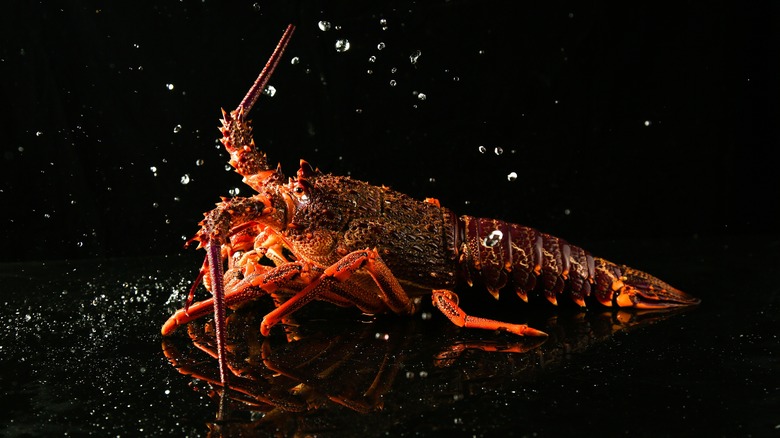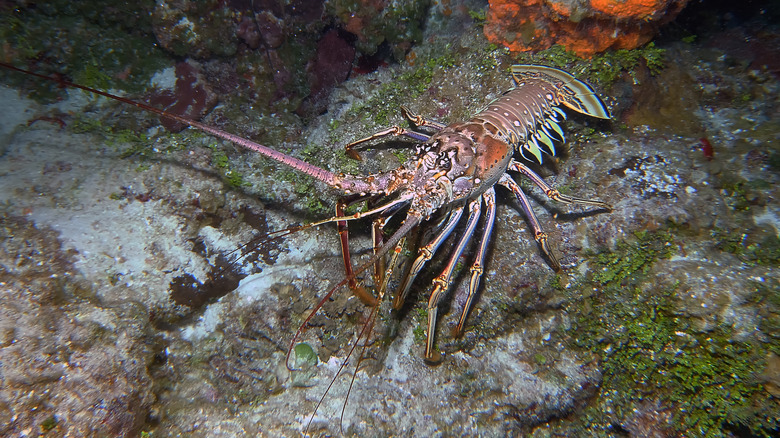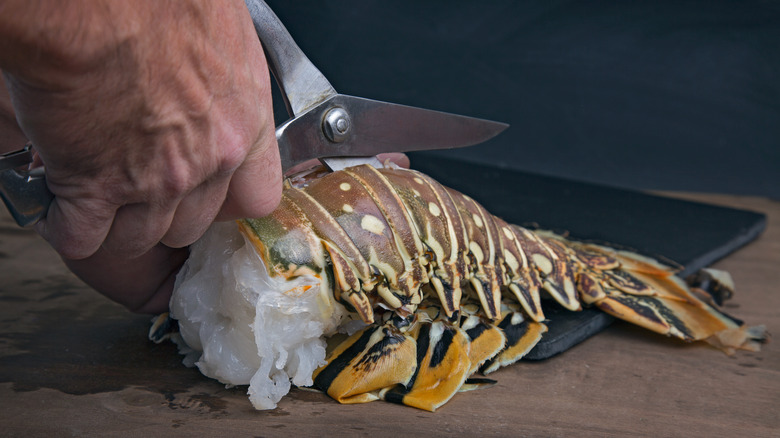The Vital Info You Need To Know Before Buying A Warm Water Lobster
Lobster is the ideal date night dinner. It's the epitome of decadence, plus it doesn't hurt that lobster is considered an aphrodisiac by many. However, it's far from a perfect food with price, availability, and the cooking process poses challenges to some. Depending on where you live, accessing live lobsters can be quite difficult, and on those occasions that you do get your hands on one, let's just say that dropping a whole wriggling animal into a boiling pot isn't appealing to many. That's where lobster tails come into the picture, presenting us with an option that is generally easy to find and far less intimidating to cook.
The tail is the meatiest part of the lobster and is widely considered to have the best flavor, being sweeter and less fishy than the rest of the crustacean. You can often find lobster tails for sale even where live lobster is unavailable (the caveat is that it may come frozen), and it's a less daunting thing to cook than the entire thing. Of course, one of the biggest keys to lobster's glamorous allure is its price tag, often touching upward of $50 per pound, which can present another hang-up for many shoppers. If you go shopping for the most affordable lobster tails, you'll soon find two options: Cold water tails and warm water tails, with the latter being significantly less expensive. But are the savings really worth it?
Cold water lobsters vs. warm water lobsters
You wouldn't guess it from their names, but cold-water lobsters and warm-water lobsters come from different biological families. Cold water lobsters, also known as "true lobsters," belong to the Homaridae family (also called Nephropsidae). Warm water lobsters, on the other hand, belong to the Palinuridae family and are also known as "spiny lobsters." The most popular species of true lobster are the American lobster and the langoustine, and these (particularly the former) are what you probably picture when you think of lobster. True (cold water) lobsters have large front claws for hunting, which are a gift to hungry humans since they also contain sizable portions of meat. Spiny (warm water) lobsters have no claws and much larger antennae.
The cold and warm water designations refer to the native habitats of each lobster family. Cold-water lobsters are found in the high latitudes of the North Atlantic. They're most famously caught off the coast of Maine but also show up in Canada and Western Europe and near Australia, New Zealand, and South Africa. Warm water lobsters are found in regions closer to the equator, such as the Florida and California coasts, the Caribbean, and even the Mediterranean Sea. The stark environmental differences of their respective homes have a profound effect on each type of lobster meat.
The meat differs in both flavor and texture
Cold-water and warm-water lobster are not interchangeable. Living in a cold environment causes true lobsters to grow slower, developing firm yet tender meat. They taste sweet and not overpoweringly fishy. On the other hand, warm-water lobsters have softer meat, which presents a more significant challenge to the cook because it can become mushy. The warm water variety has also been noted for having a briny, fishy flavor, and some people complain that it carries a faint scent of ammonia.
Since warm-water lobsters lack claws, they are less meaty overall. The tail is the only edible portion, and therefore you will often see warm water lobster tails sold independently, pre-cut from the rest of the body. Even if they aren't clearly labeled, you can easily differentiate between the two by their appearance. Spiny lobsters, naturally, have small spines on their shells, but there's also a significant color difference. Cold-water lobsters tend to have a dull, green-brown hue, while warm-water lobsters have a light orange or pink shade.
Generally, cold-water lobster is favored over warm water for its firmer texture and sweeter flavor. This, in turn, means a higher price tag. However, this mainly applies to American and European cuisines, where lobster is prepared with little-to-no seasoning. In China, both varieties of lobster are highly prized and prepared with flavorful additions like ginger, scallion, pepper, or fermented soybean sauce.


